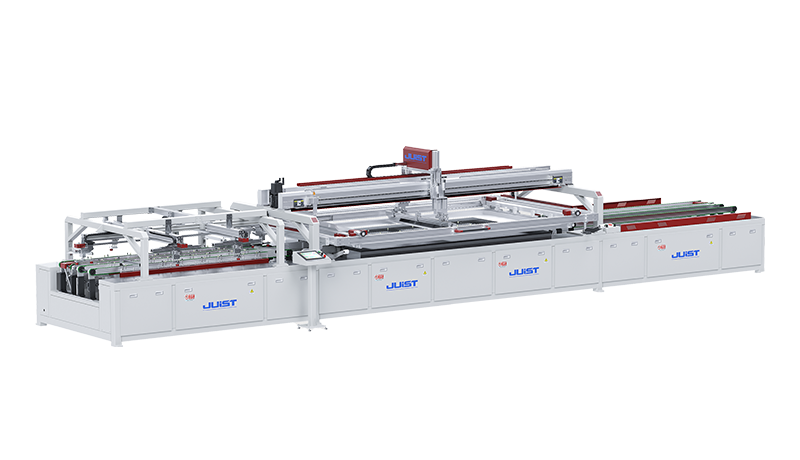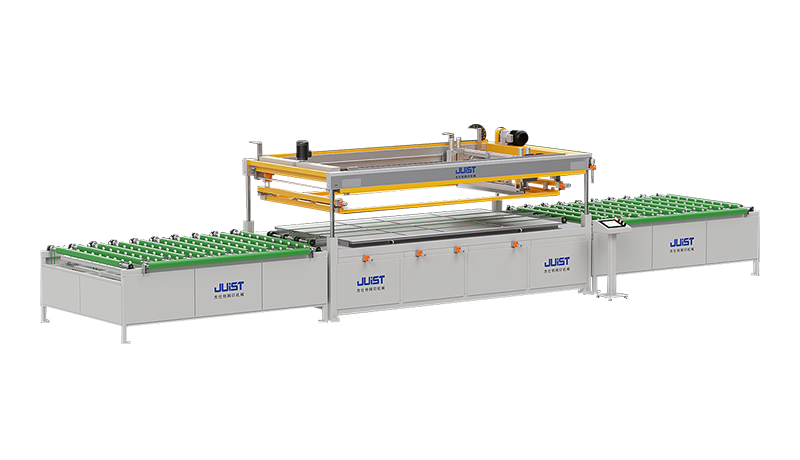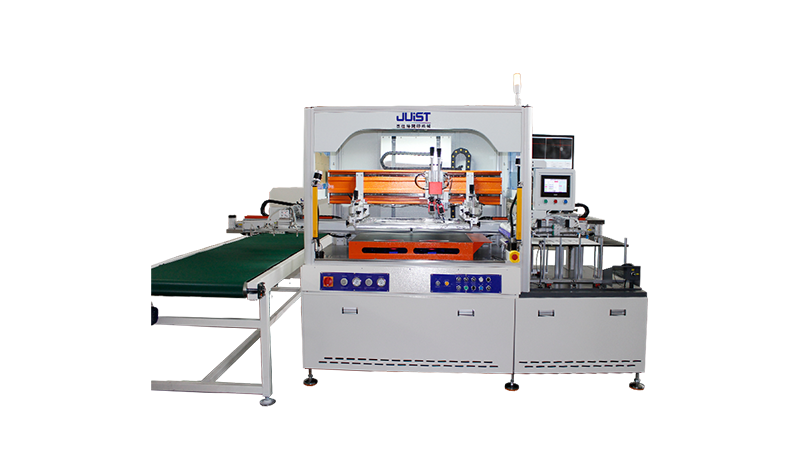+86-519-83387581
How to Quickly Master the Operation Process of a Small Automatic Photoelectric Glass Printing Machine
Although the operation process of a small automatic photoelectric glass printing machine is not overly complex, it is essential to follow standardized steps to ensure printing quality and prevent equipment damage. Initially, operators must conduct a pre-operation check to verify that all components of the machine are in normal condition—this includes confirming the sensitivity of the photoelectric sensing device, the cleanliness of the printing nozzles, and the smoothness of the glass conveying track. Only after ensuring no abnormalities are found should the power be connected and the machine started. Next, equipment parameters need to be adjusted according to the size of the glass to be printed, covering aspects such as printing area positioning, ink thickness settings, and printing speed regulation. This step requires repeated calibration based on the actual specifications of the glass to ensure precise photoelectric positioning, thereby avoiding printing offset issues. Subsequently, the glass is placed stably on the conveying track, and the automatic conveying function is activated to allow the glass to slowly enter the printing area. During this phase, operators must monitor the printing process in real-time, paying close attention to whether the ink is evenly distributed and whether the pattern is complete; if any abnormalities are detected, the machine should be paused immediately for adjustments. Finally, the printed glass is transported to the drying area via the conveying track, and it can only be picked up after the ink has completely dried. Throughout the operation, it is crucial to wear protective gloves to prevent glass scratches or ink stains on the skin, while also avoiding contact with moving parts when the machine is running to ensure operational safety.
What Key Details Should Be Focused on for Daily Maintenance of Automatic Photoelectric Glass Printing Machines
Daily maintenance of automatic photoelectric glass printing machines directly impacts the equipment’s service life and printing accuracy, so several key details must be prioritized. First and foremost is cleaning: after each use, the printing nozzles should be cleaned promptly. Special cleaning agents can be used to soak the nozzles, followed by gentle brushing with a soft bristle brush to remove residual ink—this prevents nozzle clogging that could affect future use. Meanwhile, the glass conveying track should be wiped down to remove dust and ink residues, maintaining smoothness and avoiding glass jams caused by impurities. Secondly, maintenance of the photoelectric sensing device is essential. The sensitivity of the sensing probe should be checked regularly; a clean cotton cloth can be used to wipe the probe surface to remove oil and dust. If reduced sensitivity is detected, the probe angle should be adjusted or professional personnel contacted for calibration to ensure the machine can accurately identify glass positions. Furthermore, lubrication and maintenance are necessary: transmission components such as gears and bearings require monthly application of special lubricating oil to reduce wear and maintain smooth operation. However, it is important to control the amount of lubricating oil to prevent excess oil from spilling and contaminating the equipment or glass. In addition, the machine’s circuit system should be inspected regularly to check for aging or damaged wires and loose terminal connections, ensuring safe and reliable circuit connections to prevent equipment failures caused by electrical issues. Finally, it is recommended to establish a maintenance record log, detailing the time, content, and equipment status of each maintenance session. This helps identify potential problems in a timely manner and take preventive measures in advance.
Which Glass Materials Are More Suitable for Processing by Automatic Photoelectric Glass Printing Machines
Automatic photoelectric glass printing machines have specific requirements for glass materials, as not all types of glass can achieve ideal printing results—thus, it is necessary to clarify suitable glass material types. Ordinary float glass is one of the most commonly used materials; it features a flat surface, uniform thickness, and good light transmittance, allowing the photoelectric sensing device to achieve precise positioning. When printed, ink adheres strongly to this glass and does not easily peel off after drying, making it suitable for producing ordinary glass decorative paintings, glass nameplates, and similar products. Ultra-white glass is also a highly suitable material; with low impurity content and high transparency, it ensures printed patterns appear more vibrant and detailed. This makes it particularly ideal for scenarios requiring high visual quality, such as high-end furniture glass and display cabinet glass. Additionally, tempered glass can be processed by automatic photoelectric glass printing machines after special treatment, but attention must be paid to the flatness of the tempered glass surface. Slight deformation may affect printing accuracy, so flatness testing should be conducted on tempered glass before processing to ensure it meets equipment requirements. In contrast, glass materials with uneven surfaces—such as frosted glass and patterned glass—are less suitable. The surface texture of these materials disrupts the accuracy of photoelectric positioning, and ink struggles to adhere evenly to uneven surfaces, often leading to incomplete printed patterns or ink peeling. Therefore, when selecting glass materials, priority should be given to types with flat surfaces and uniform textures to guarantee printing quality.
What Should Be Prioritized When Purchasing a Low-Cost Automatic Photoelectric Glass Printing Machine
When purchasing a low-cost automatic photoelectric glass printing machine, one should not solely pursue low prices but instead consider multiple factors comprehensively to ensure the equipment’s cost-effectiveness. First, printing accuracy should be a key focus. This can be evaluated by examining parameters of the machine’s photoelectric positioning system and printing resolution. It is also advisable to conduct on-site printing tests to observe whether patterns are clear and edges are neat, avoiding quality issues caused by insufficient accuracy. Second, equipment stability is crucial. Low-cost machines may use inferior components, leading to frequent failures. Therefore, it is necessary to understand the brand of core components—such as motors, nozzles, and photoelectric sensors—and select parts with good reputations and high durability. 同时,the machine’s heat dissipation system should be checked to ensure it is well-designed, preventing performance degradation due to overheating during long-term operation. Furthermore, after-sales service is often overlooked for low-cost equipment but is essential, as problems are inevitable during use. It is important to confirm whether the supplier provides services such as installation and commissioning, maintenance, and technical consultation, as well as whether spare parts are supplied promptly—this avoids production delays caused by after-sales issues. In addition, energy consumption and floor space should be considered; the appropriate power and size of the machine should be selected based on actual production needs, ensuring it meets operational requirements while reducing long-term usage costs. Finally, it is recommended to compare products from multiple suppliers, evaluating factors such as price, performance, and after-sales service comprehensively to select the low-cost automatic photoelectric glass printing machine that best suits one’s needs.
How to Troubleshoot Common Faults of Automatic Photoelectric Glass Printing Machines
Automatic photoelectric glass printing machines may encounter various common faults during use; mastering correct troubleshooting methods enables quick restoration of equipment operation and minimizes losses. If a printed pattern is offset, the first step is to check whether the photoelectric positioning device is contaminated by dust or ink. After cleaning the sensing probe, re-calibrate the positioning parameters. If the issue persists, inspect whether the glass conveying track is deformed or jammed, adjust the track position or replace worn components to ensure smooth glass conveyance. When printing nozzles become clogged, try soaking the nozzles in a special cleaning agent for 10-15 minutes, then activate the machine’s nozzle cleaning function to flush the interior of the nozzles with the cleaning agent. For severe clogs, the nozzles can be disassembled and gently unclogged using a soft needle, but care must be taken not to damage the nozzle holes. After processing, test whether the nozzles dispense ink evenly. If the machine experiences glass conveying jams, first turn off the power, check for foreign objects blocking the conveying track, and clean them. Then, inspect whether the track bearings are worn; if the bearings do not rotate smoothly, add lubricating oil or replace the bearings. 同时,check whether the conveying motor is functioning normally—if the motor speed is abnormal, contact professional personnel to repair the motor. When the machine fails to start, first check the power connection to see if the power cord is loose or damaged. After replacing the power cord, if it still fails to start, inspect the machine’s circuit protection devices (such as fuses) and replace any blown fuses before attempting to start again. If the problem remains, troubleshoot the control board for faults. In this case, do not disassemble the machine independently; instead, contact the supplier or professional maintenance personnel for inspection and repair to avoid exacerbating the fault due to improper operation.










